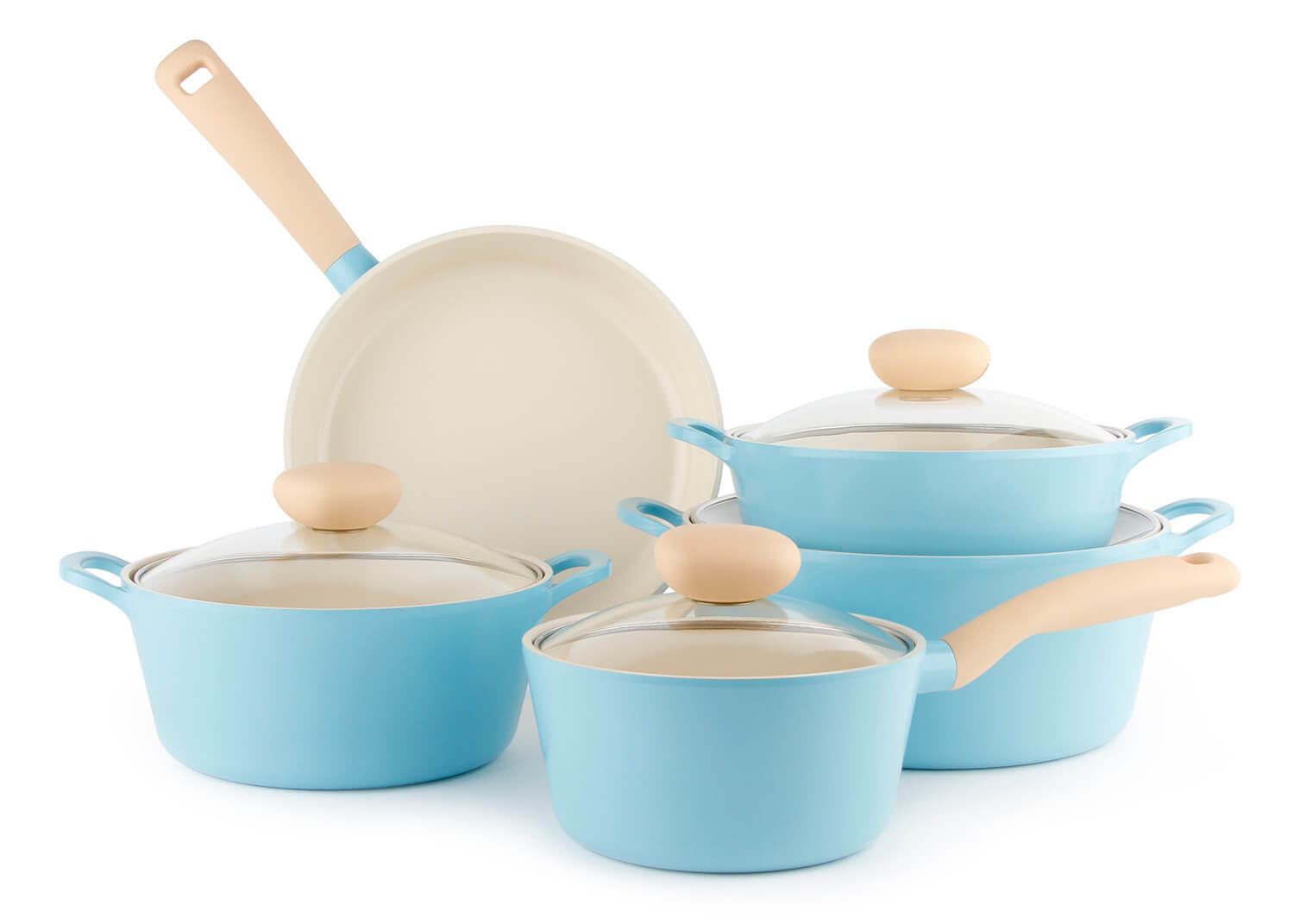It’s Pie Making Boot Camp Week #2! Today’s detailed picture AND video tutorial will show you how to make perfect homemade pie crust! Bonus: I’m sharing a brand, new, no-fail pie crust recipe!
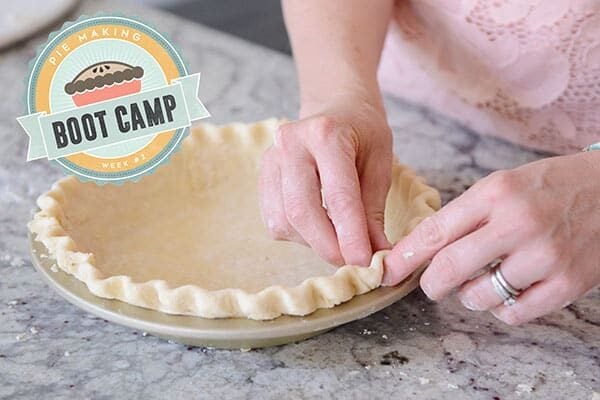
This might possibly be the most important week of our 4-week Pie Boot Camp series!
The crust!!
Does the thought of making homemade pie crust give you a nervous twitch?
Or are you a homemade pie dough rock star?
Well, no matter where you fall on the spectrum, today, my goal is to take all the mystery and stress and angst out of making homemade pie dough.
Armed with last week’s list of pie making equipment essentials, we can dive right in to learn how to make perfect homemade pie crust.
In today’s post, I’m giving a super in-depth look at every step of homemade pie crust, PLUS, we’ll be talking about common pitfalls and how to troubleshoot if things go wrong.
Included is both a picture tutorial with lots of description and tips as well as a quick 2-minute video tutorial for an extra level of visual help.
What Recipe Should I Use?
The pie crust recipe you use is almost as important as what you choose to fill that pie with!
Most of you probably know that I am insanely in love with this amazing pie crust recipe I posted a couple years ago. It is the pie crust recipe I make 90% of the time.
However, in the interest of keeping things open-minded and giving you options, today, I’m sharing my other standby pie crust recipe (printable version is at the bottom of this post).
It is super simple to make, very easy to work with, and produces a flaky, tender crust that is downright enviable in the world of pie making.
(The reason I slightly prefer the sour cream pie crust is because the flavor is better, in my opinion, and the crust is just slightly more tender.)
I’ll be using this “new” pie crust recipe today in both the picture and video tutorial, but the sour cream pie crust recipe could easily be substituted when going through the tutorial as it is very similar.
I took one for the team and ripped up a baked pie crust so I could show you JUST how flaky this pie crust is. Look at those layers!
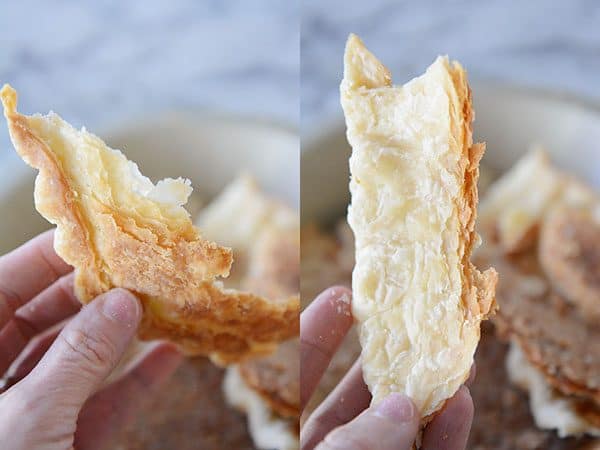
That right there is pretty much pie crust amazingness. And you can make it, too!
Even though many people make pie crust in the food processor (I do as well, at times), I’m demonstrating in both the picture AND the video tutorial how to make the pie crust by hand (it’s actually so super easy) since I know not everyone has a food processor.
{For an additional boost of help, here’s the video I already have in the archives dedicated to that favorite sour cream pie crust above. Plus, it has a cameo appearance by my favorite sous chef, and she’s downright hilarious.}
Ok, let’s get to it!
On a starting note, one of the best tips I can give you for pie crust success is using cold ingredients and keeping the pie dough cool all the way through the process of making it.
If your kitchen is blazing hot, it may not be the right time to make pie dough. If you are sweating, so will the pie dough. I’d say the ideal air temperature should be about 68-72 degrees F.
If the fat (butter/shortening) gets too warm, it will spell disaster – both in making the pie dough but also in how it bakes (the crust might shrink or be dense and heavy if the ingredients weren’t kept cool).
To prepare for today’s tutorial, you’ll want to throw ten tablespoons of butter in the freezer to hang out for 20-30 minutes.
Also, chill two tablespoons shortening in the refrigerator for several hours (or my cheater method: scoop the shortening onto a plate with a cookie scoop that’s been lightly greased with cooking spray and pop it in the freezer for 15-20 minutes).
For this pie crust, add 1 1/2 cups all-purpose flour to a medium-size bowl, followed by 2 tablespoons sugar and 1/4 teaspoon salt.
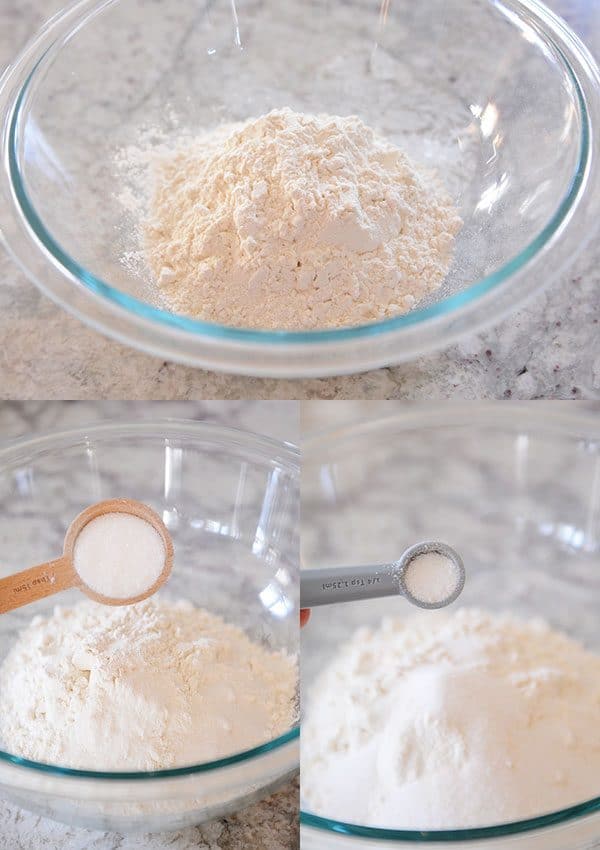
Give that mixture a quick stir with a fork.
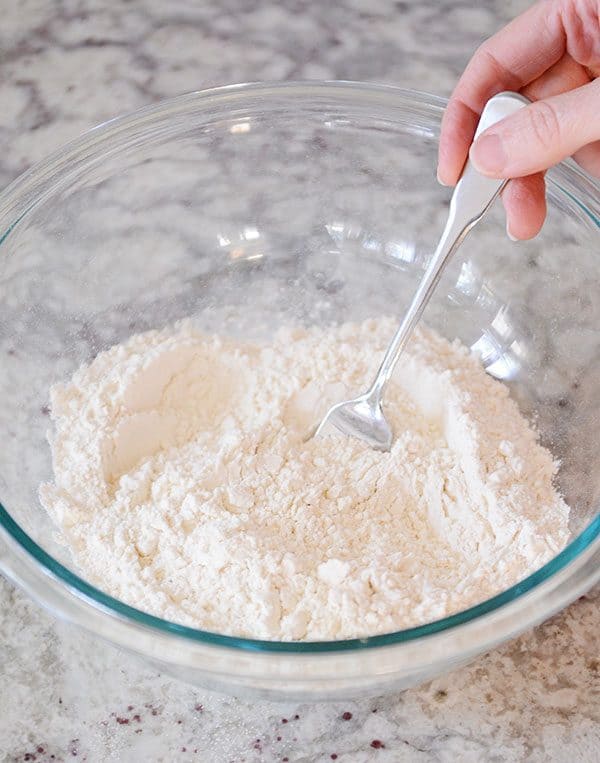
Now, add the chilled shortening (two tablespoons).
If you are wondering who I am and how did I get here because I’m recommending you use shortening, stick with me for a second.
I know this might be the only recipe on my site to ever call for shortening, but for those that are new to pie crust, shortening may quickly become your friend.
It isn’t as finicky to work with as butter is, and even a mere two tablespoons (in addition to the butter we’ll be using in a sec) lends a light flakiness to the crust that can be hard to achieve with 100% butter.
I am not a fan of pie crusts made with all shortening (butter-flavored shortening or not) because of the greasy aftertaste and lack of flavor, but this pie crust recipe hits the sweet spot of ultimate butter flavor and flakiness that is helped along by the shortening.
It is great for those wanting to conquer pie dough once and for all.
Now grab that pastry blender and start working the shortening into the dry ingredients.
TROUBLESHOOTING TIP: No pastry blender? No worries. You can work the shortening in with a fork or two butter knives.
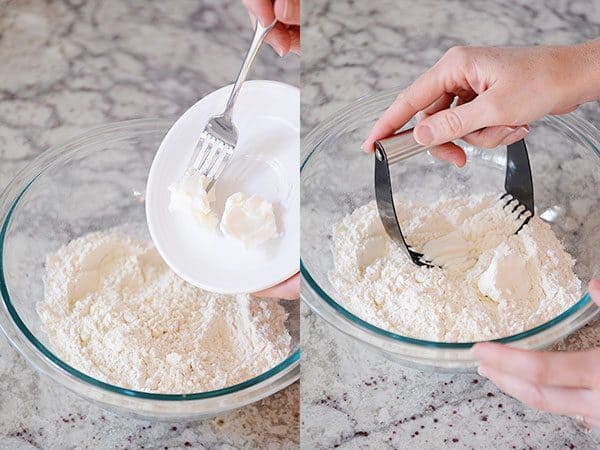
This step should only take a minute or two.
The pieces of shortening should be about pea-size.
Don’t work them in too much – those pieces of fat (same will go for the butter) melt during baking and release steam which creates little pockets of air in the pie crust…and all of that equals the crazy flakiness you are after.
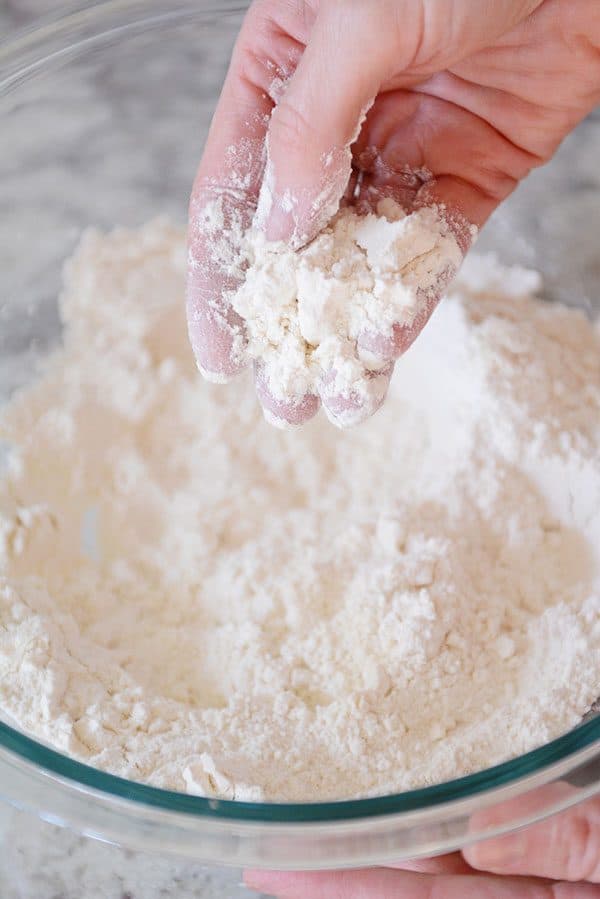
Now, using a box grater, shred the frozen butter right into the bowl.
This is much easier than cutting the butter into the flour mixture like we did above with the shortening (FYI: shortening doesn’t grate well on a mixer like the frozen butter does).
TROUBLESHOOTING TIP: If you don’t have a box grater, instead of freezing the butter, make sure it is well-chilled, then cut it into 1/4-inch pieces and add it to the dry ingredients and cut it in with a pastry blender or two forks or butter knives until the mixture is coarse and the butter is in pea-sized pieces.
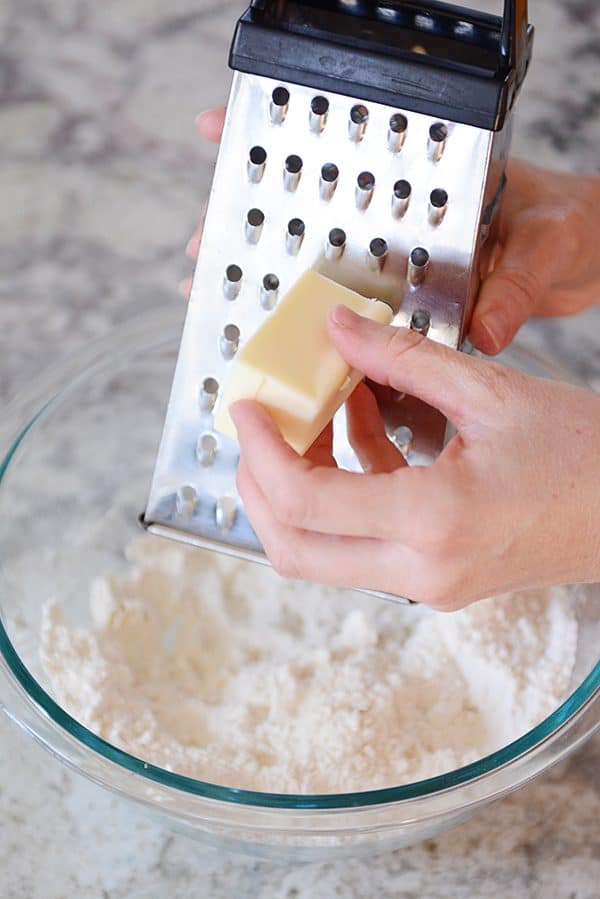
I usually grate half the butter in, give the mixture a toss, and then grate the other half.
But you can do it all at once. It’s hard to mess up.
Once all the butter has been added, toss lightly with your hands or a fork until the butter strands are evenly coated with the dry ingredients.
Don’t overwork or overhandle the mixture to the point that the butter pieces start getting soft or melting from the heat of your hands!
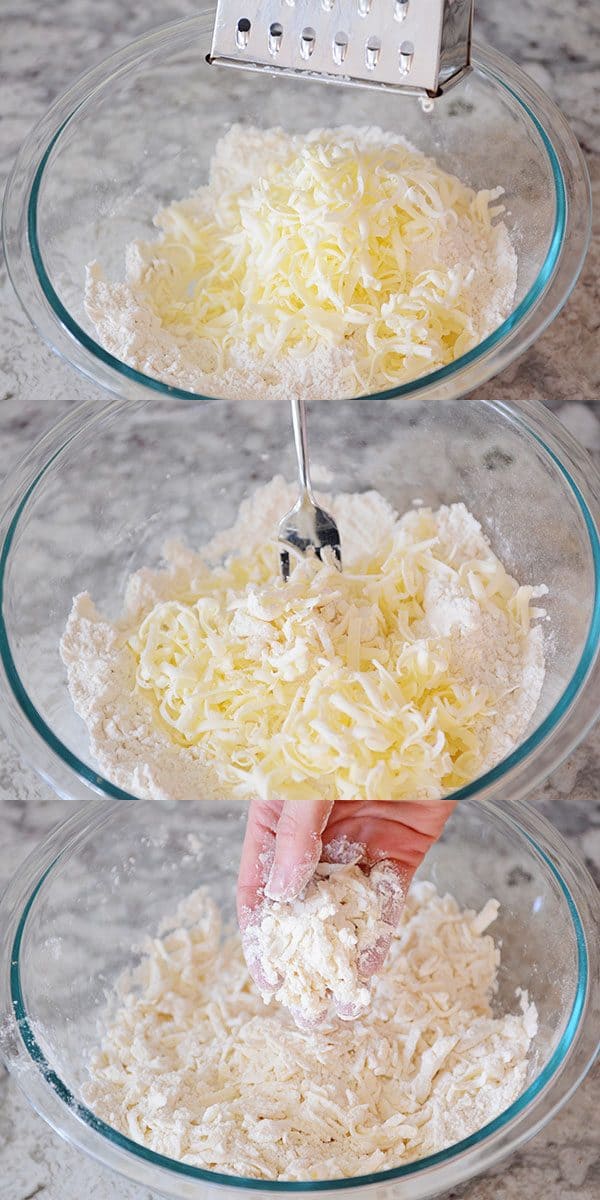
Drizzle in the ice water, starting with the lesser amount (1/4 cup) and adding more (up to 1/3 cup TOTAL) only if the mixture is incredibly dry.
Use a fork to start moistening the ingredients.
Eventually, I always end up abandoning the fork and gathering the mixture together with my hands.
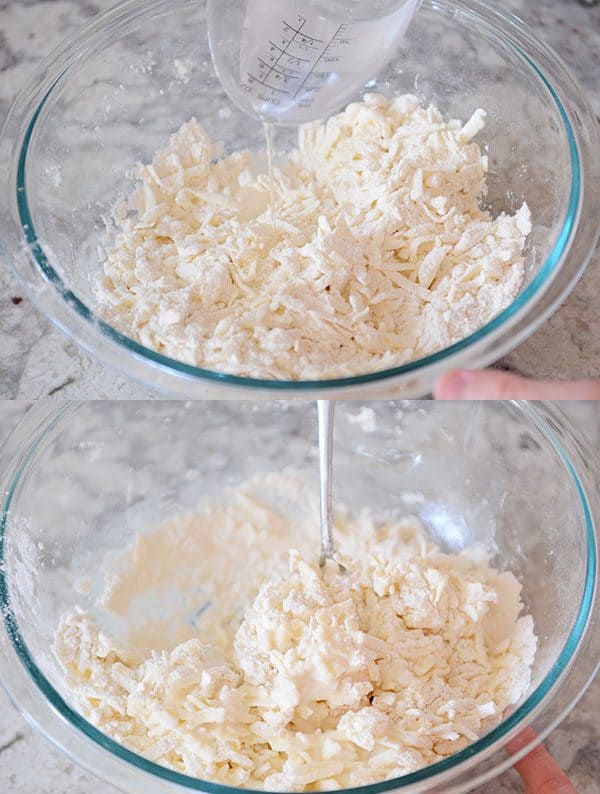
When you can press a handful of the pie dough together and have it mostly stay together in a clump (even if there are dry patchy spots), you are golden.
Stop mixing, and for the love, do not add any more liquid!
You can see below that the dough looks pretty shaggy. But it’s also coming together in a general mass.
When it begins to clump together like this, I gather up all the excess mixture at the bottom of the bowl and press it into a lumpy ball.
If you are new to pie making, it might feel uncomfortable to not continue adding water until the dough resembles, say, sugar cookie dough.
But I promise it’s ok if your pie dough looks like this! It’s better to have dry pie dough rather than overly wet pie dough.
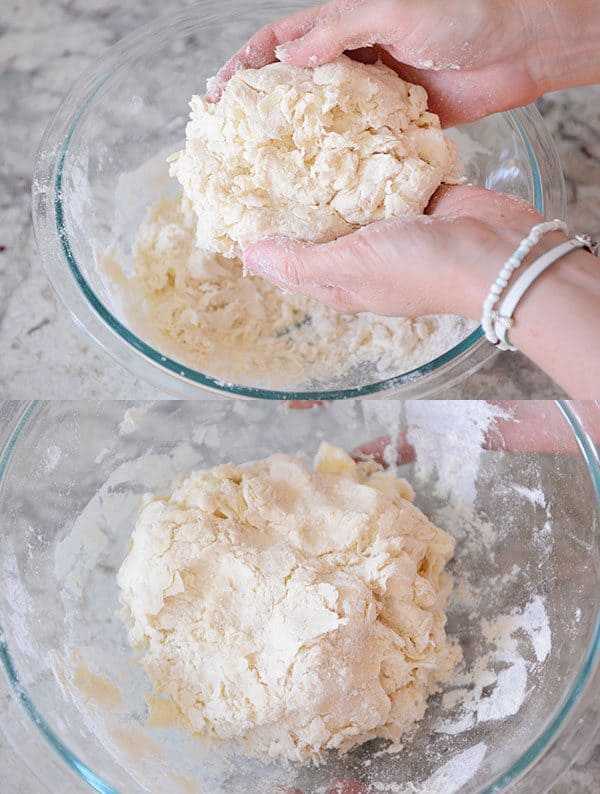
I think one of the biggest surprises and also one of the biggest pitfalls with homemade pie dough is how dry it may look after mixing – and resisting the urge to overmix or add more water.
Gather the dough together and place on a long piece of plastic wrap.
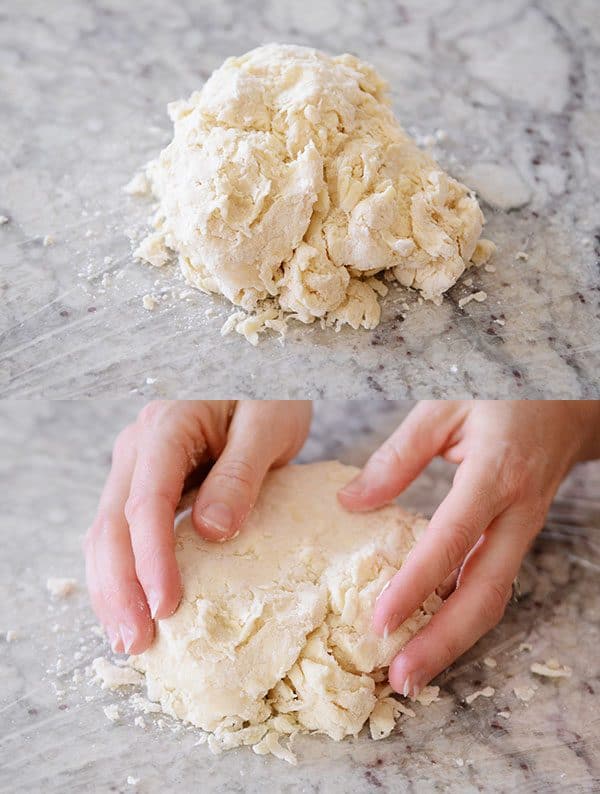
Mold it lightly into a thick disc.
Then, lift up the edges of the plastic wrap so the pie dough is covered completely. Refrigerate for at least an hour or up to several days (or freeze for a couple months).
TROUBLESHOOTING TIP: What happens if the dough falls completely apart when it is placed on the plastic wrap? If, at this point, you realize that you really did need to add more water, grab a spray bottle and lightly mist (very lightly!) the outside of the pie dough, patting excess dry ingredients back into a rough disc shape. While it rests in the fridge, the pie dough will absorb that extra liquid so it’s easier to roll out.
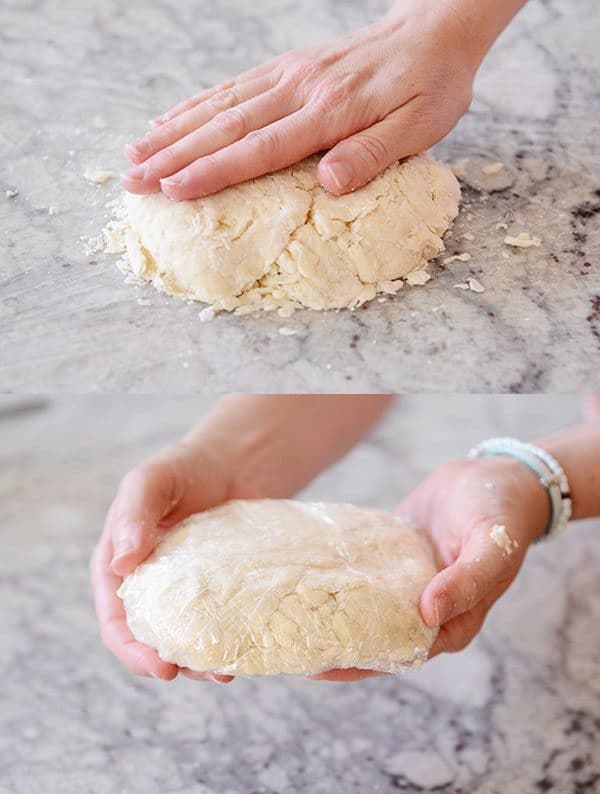
When the pie dough is ready to be rolled out, I always reach for my canvas board.
Purchasing this $25 piece of pie making equipment several years ago completely changed the way I felt about making homemade pies AND how my pie crusts turned out. Even though I’m not one to recommend buying unnecessary equipment, I highly recommend a canvas-covered board like this.
TROUBLESHOOTING TIP: If you don’t have a board like this, never fear! In the video tutorial below, I’m not using the board to roll out the pie dough. Just a good old-fashioned lightly floured counter. The biggest tip when using a floured countertop is to make sure to lift and turn the dough often (and swipe flour underneath, as needed) so it doesn’t stick.
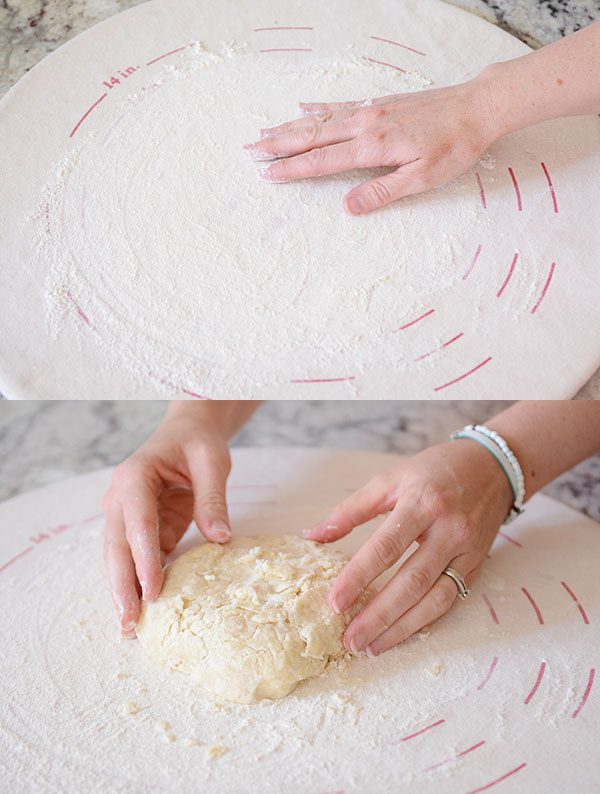
Using a rolling pin, press the center of the pie dough and give a quick roll.
Turn the dough a quarter turn, and again, starting in the middle, roll out a few times.
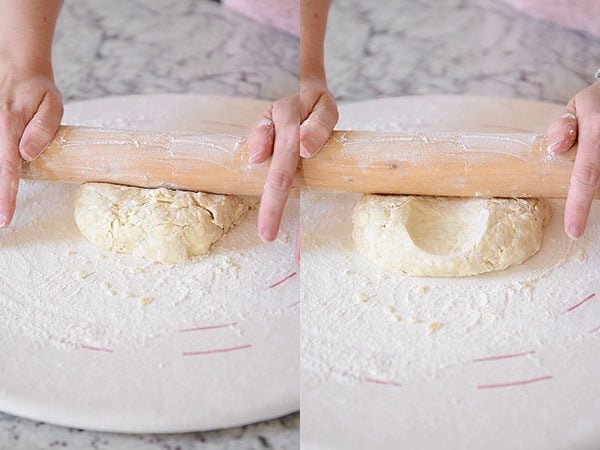
Continue this process of rolling from the middle and turning the pie dough until the pie dough is in a thin, even layer to the size you need it.
I like to hold the pie plate I’m using upside down in the middle of the dough to make sure it’s rolled wide enough.
My general rule of thumb is to roll the pie dough 2-inches wider than the outside rim of the pie plate.
Try to get the pie dough rolled out in as few rolls as possible (basically, don’t roll it to death). This will help the ingredients stay cold so it bakes up nice and flaky.
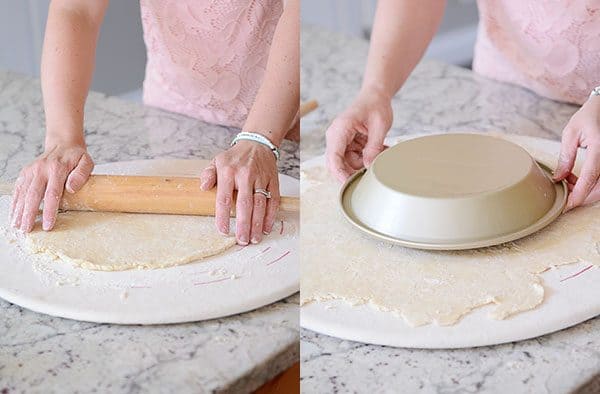
Lightly flour the rolling pin and starting at one edge, roll the dough up around the rolling pin.
If the dough feels too sticky to do this, before rolling it up, make sure there is a light sprinkle of flour on top of the dough and that you can easily lift all sides of the dough up from the canvas board (or counter).
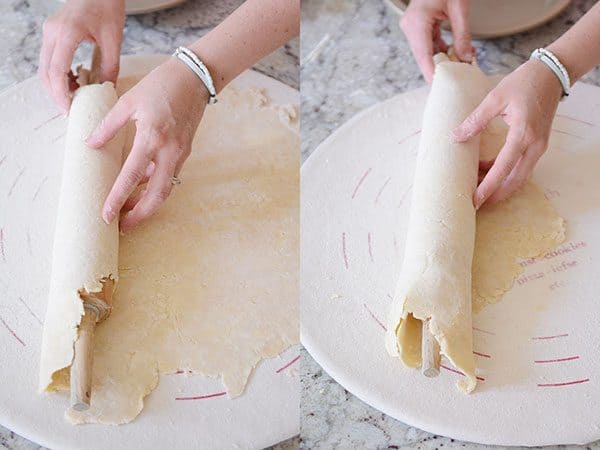
Now, unroll the pie dough over the pie plate, centering it as good as you can so you don’t have to stretch or move it too much once it is completely unrolled.
TROUBLESHOOTING TIP: What if the pie dough cracks or breaks while rolling or unrolling? If this happens, don’t stretch the pie dough to cover up the hole or tear. Instead, very, very lightly spray the area with cold water (just a drop, or less than) and take a small piece of dough from excess overhang and press it lightly to that area to cover the hole.
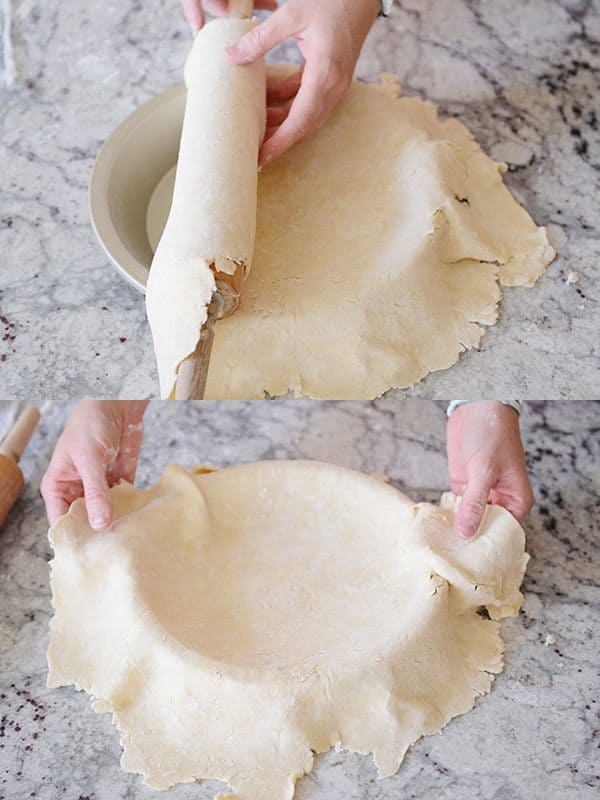
To get the pie dough perfectly nestled into the shape of the pie plate instead of pushing the dough down into the corners and molding it to the pie plates’ shape, lift up on the edge of the pie dough which will free up the slack of the pie dough, and using your other hand, move the dough down into the corner.
The key? No stretching or pulling. Just lifting and fitting.
Does that make sense?
This is really important so that your pie crust DOES NOT SHRINK while baking.
Stretched out dough is going to want to shrink right back up while backing, and that will make you sad (and me, too).
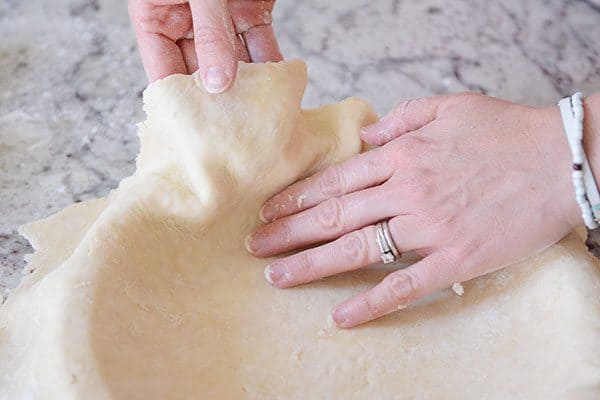
There we go. Perfectly lifted and fitted pie dough.
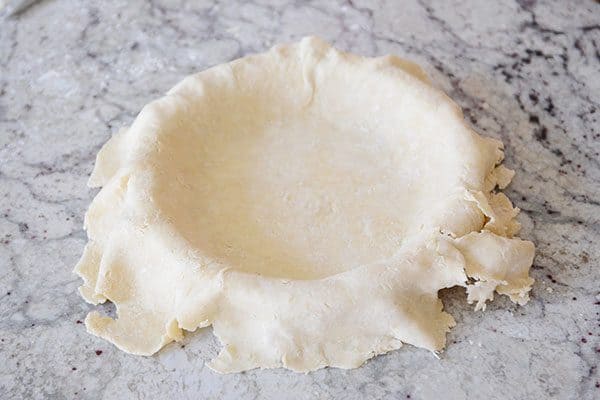
My favorite tool for trimming down the pie dough is kitchen scissors.
Snip the dough, leaving about 1/4-inch overhang (so, don’t trim it right up to the edge of the pie plate – you’ll see why in a second).
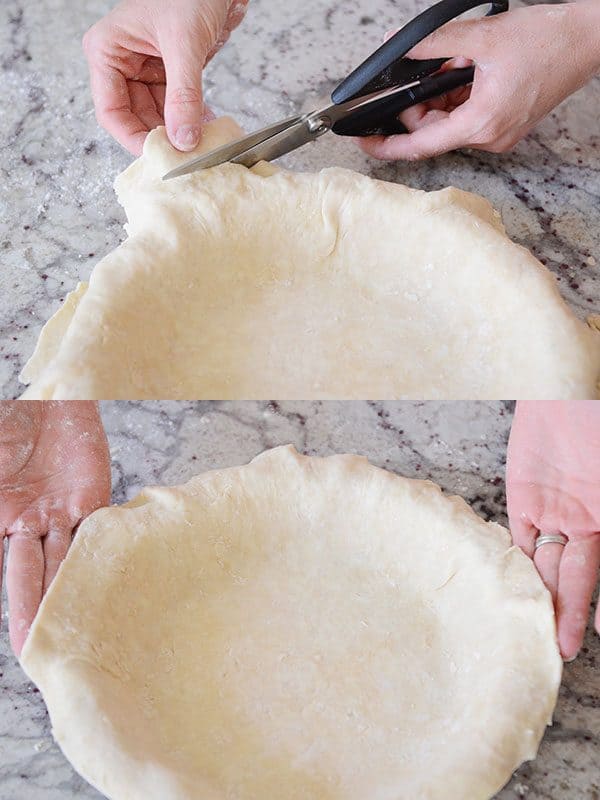
Take that 1/4-inch overhang and fold it underneath so it is flush with the edge of the pie plate.
Important note: you only want to do this if you are making a single crust pie and will be crimping the edges to blind bake (we’ll talk about this next week) OR to fill and bake. If you are making a double crust pie and will be filling the pie, adding a top crust, and then baking, leave the 1/4-inch overhang. In one of the next few weeks, I’ll be showing you how to add a top crust and where to go from there.
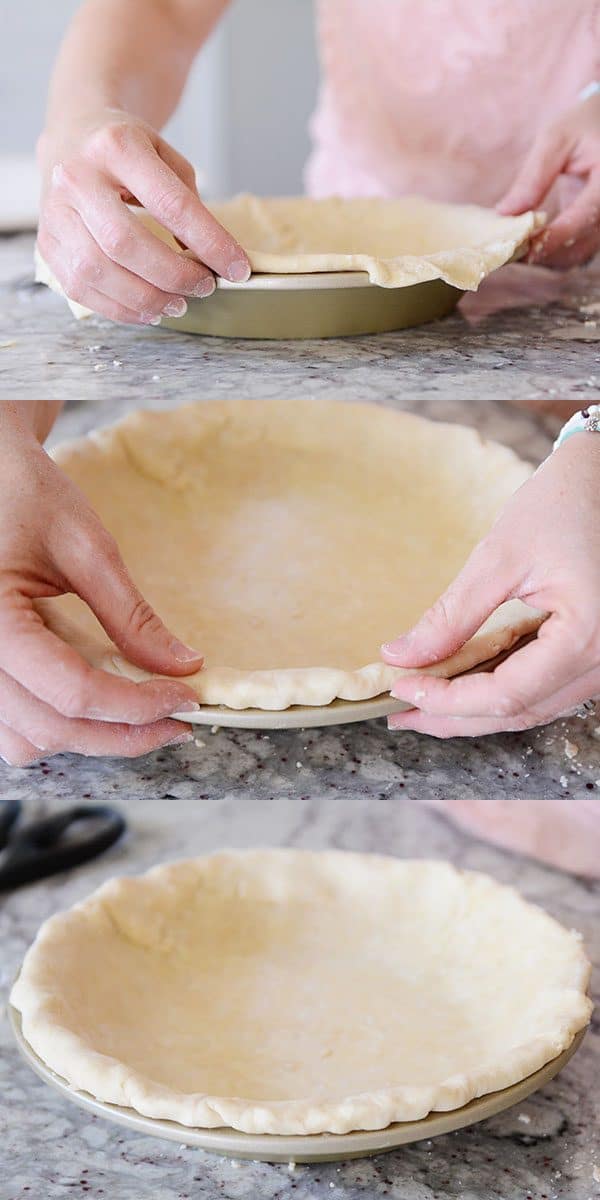
Those edges are ready for crimping! Folding the pie edges under like that gives a thicker edge so the crimping is prettier AND it helps with the pie crust shrinking during baking.
Using the thumb and forefinger of one hand on the inside of the pie plate and the forefinger of the other hand on the outside edge, press together and crimp the edges for a classic pie crust look.
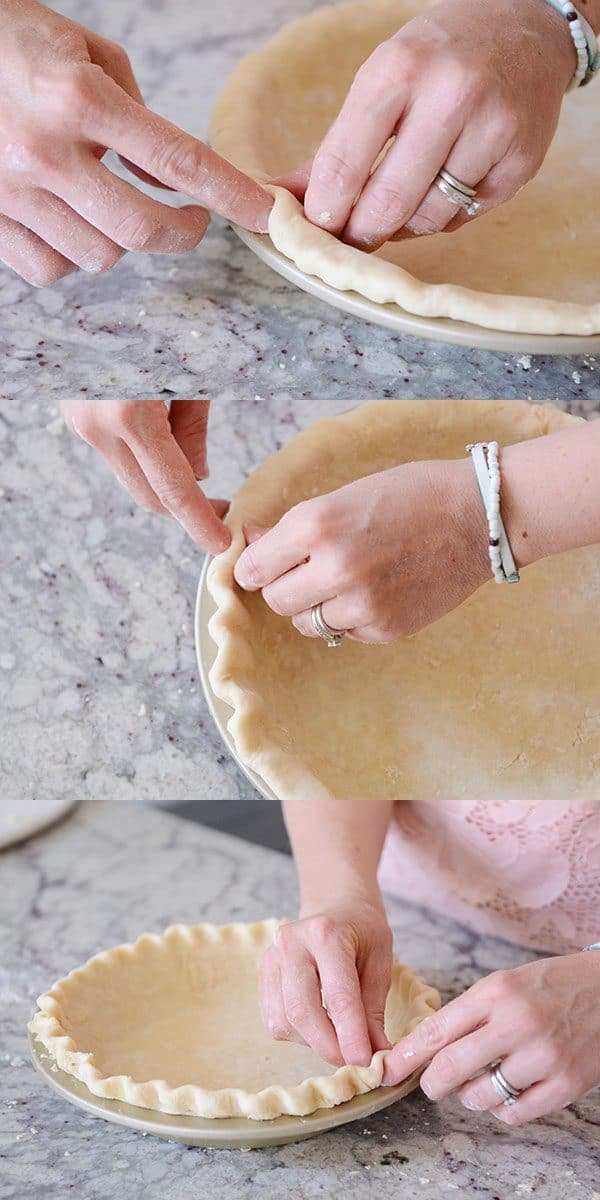
We’ll talk more next week about what to do with this gorgeous pie crust from here (so many options, so little time).
But the safest thing to do is to lightly cover it with plastic wrap and pop it in the fridge for about an hour.
It’s a rare pie crust that doesn’t benefit from chilling time on the front or back end (it helps with that dreaded shrinking problem!).
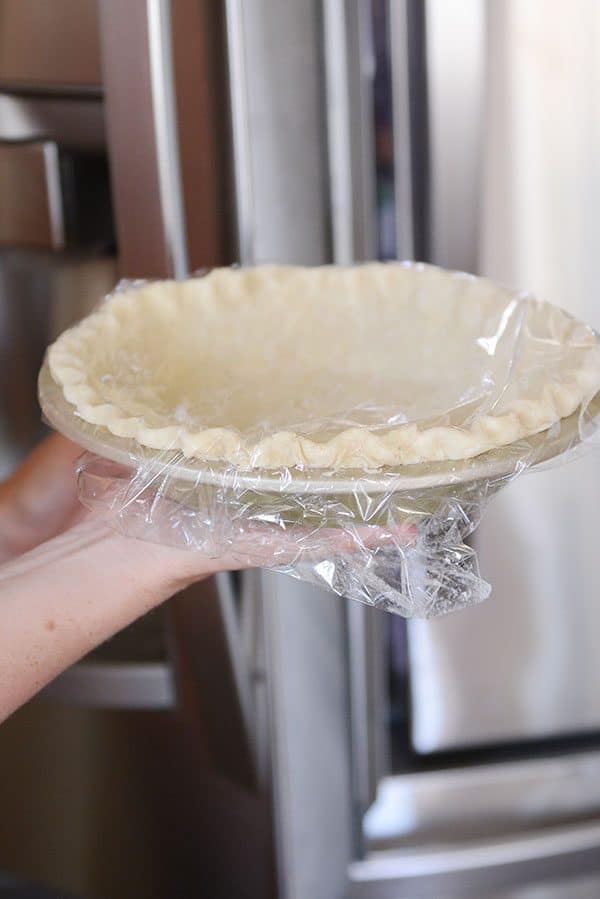
I honestly believe that learning how to make perfect homemade pie crust is one of the most rewarding things in life!
A few ending notes:
Please leave any and all questions, comments, near panic attacks, success stories, etc., in the comments below! I will respond to each and every one. Promise.
Get the recipe for today’s pie crust demo below.
The video tutorial is also right down there if you scroll another few inches.
Next week we’ll be attacking all things blind baking (why, what, how, who am I??) + I’ll be sharing an amazing, new, easy chocolate ganache cream pie recipe (that goes along with this beautiful pie crust you learned to make today) + we’ll be addressing many of the common pitfalls that happen when baking pie crust.
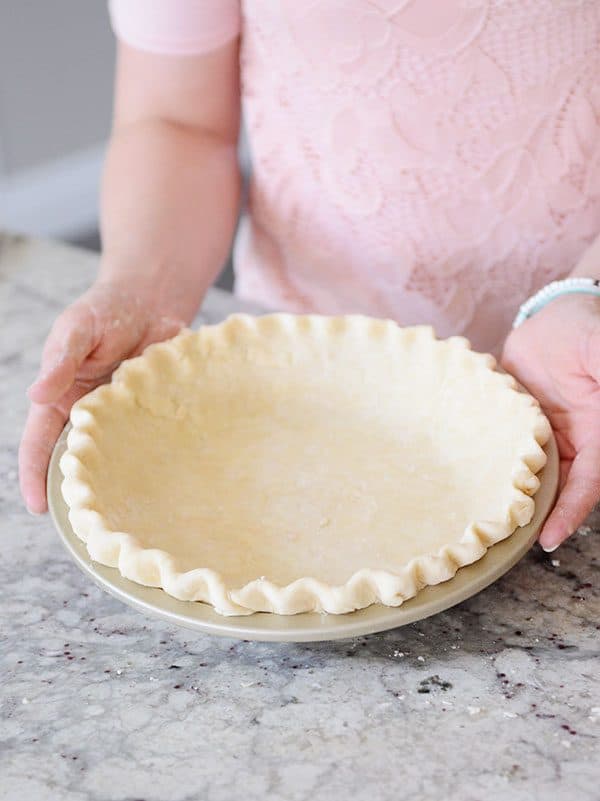
Video Tutorial
Yield: 9-inch pie crust
Perfect Flaky Pie Crust

Ingredients:
- 1 1/2 cups (7.5 ounces) all-purpose flour
- 2 tablespoons granulated sugar
- 1/4 teaspoon salt
- 2 tablespoons shortening, frozen for 15-20 minutes or well-chilled
- 10 tablespoons butter, frozen (see note)
- 1/4 to 1/3 cup ice water
Directions:
- In a medium bowl, add the flour, sugar and salt. Whisk together with a fork to combine.
- Add the shortening to the bowl, and cut it into the dry ingredients using a pastry blender or fork or two butter knives until the shortening is in pea-sized pieces and the mixture is crumbly.
- Using a box grater (or other cheese grater with large holes), grate the frozen butter into the bowl. Lightly toss with a fork or your hands until the butter is evenly coated with the dry ingredients (don’t overmix with your hands, especially if the warmth from your fingers softens or melts the butter).
- Drizzle in 1/4 cup of the ice water. Use a fork to begin combining the dough. Abandon the fork, if needed, and use your hands to gather the pie dough into a mass. It will be dry and patchy – that’s ok. Grab a handful of dough and press. If it clumps together, don’t add more water. If it’s still dry and falling apart, drizzle in another 1-2 tablespoons and mix lightly and quickly until the dough gathers into a shaggy ball.
- Press the pie dough (gathering in any dry pieces that may scatter or fall out) into a thick disc-shape onto a piece of plastic wrap. Cover and refrigerate for at least an hour or up to several days (the pie dough can be frozen for several months).
- Roll out and use as needed or directed (in the recipe you are using).
Notes:
I always use salted butter (baking purists look aside), because it is what I have on hand. If using unsalted butter, increase the salt amount to 3/4 teaspoon.
All images and text ©.
Follow @melskitchencafe on Instagram and show me the recipes you are making from my blog using the hashtag #melskitchencafe. I love seeing all the goodness you are whipping up in your kitchens!
Recipe Source: adapted a little from Dorie Greenspan’s Good for Almost Everything recipe (reduced the shortening just a bit, use salted butter and less salt overall, adapted water amount slightly)

